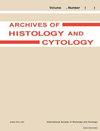Development and repair of experimental pressure ulcers in the rat abdominal wall induced by repeated compression using magnets
Q4 Medicine
引用次数: 3
Abstract
of the skin proceeded to full-thickness necrosis and/or discoloration throughout or in part of the compressed area. Necrotic skin was replaced by black/brown eschar, accompanying exudation, and significant tissue hardening. The injuries considerably contracted a few days after completing the series of compressions. The eschar further decreased gradually in size and usually became detached with time, after which a skin ulcer formed. A small number of rats showed only erosion and/or severe redness of the skin, damage which was reversible to heal without eschar formation. Generally, skin injuries seemed most severe a few days after 5 compressions and essentially healed over the subsequent 20 days. This model should prove useful for developing preventive measures and treating pressure ulcers. Summary. A better understanding of pressure ulcers requires animal models under precise experimental conditions. We here report on an improved and clinically more relevant model of pressure ulcers. Rats underwent implantation of a gold-plated magnet (25 × 20 × 2 mm) into their peritoneal cavities under anesthesia. At either 3 or 4 days postoperatively, the rat abdominal wall was repeatedly compressed at 100 mmHg (13.3 kPa) for 4 h daily for 5 consecutive days by applying another magnet to the skin while animals were conscious. The rats were reared without further treatment and the abdominal skin was photographed daily. Specimens were removed at appropriate intervals for histological examination. Edema and mild redness of the skin appeared at 1 day after the first compression. After a few repetitions of compression, edema and redness of the skin were enhanced. Subsequently, in the majority of rats, redness反复磁体压迫大鼠腹壁实验性压疮的发生与修复
整个或部分受压区域的皮肤发生全层坏死和/或变色。坏死皮肤被黑色/棕色痂所取代,伴有渗出和明显的组织硬化。在完成一系列压迫后几天,伤口明显收缩。痂的大小进一步逐渐减小,通常随着时间的推移而脱落,之后形成皮肤溃疡。少数大鼠仅表现出皮肤糜烂和/或严重的红肿,这种损伤是可逆的,可以愈合而不形成痂。一般来说,皮肤损伤在5次按压后几天似乎最严重,并在随后的20天内基本愈合。这种模式对于制定预防措施和治疗压疮是有用的。总结。为了更好地了解压疮,需要在精确的实验条件下建立动物模型。我们在这里报告一个改进的和临床更相关的压疮模型。在麻醉状态下,大鼠腹腔内植入镀金磁铁(25 × 20 × 2mm)。术后3天或4天,在动物清醒状态下,用另一磁体对大鼠皮肤施加100 mmHg (13.3 kPa)压力,每天4 h,连续5天。大鼠饲养,不作进一步治疗,每天拍摄腹部皮肤。在适当的时间间隔取出标本进行组织学检查。第一次按压后1天出现皮肤水肿和轻度红肿。反复按压几次后,皮肤水肿和红肿加重。随后,大多数老鼠出现红色
本文章由计算机程序翻译,如有差异,请以英文原文为准。
求助全文
约1分钟内获得全文
求助全文
来源期刊

Archives of histology and cytology
生物-细胞生物学
自引率
0.00%
发文量
0
期刊介绍:
The Archives of Histology and Cytology provides prompt publication in English of original works on the histology and histochemistry of man and animals. The articles published are in principle restricted to studies on vertebrates, but investigations using invertebrates may be accepted when the intention and results present issues of common interest to vertebrate researchers. Pathological studies may also be accepted, if the observations and interpretations are deemed to contribute toward increasing knowledge of the normal features of the cells or tissues concerned. This journal will also publish reviews offering evaluations and critical interpretations of recent studies and theories.
 求助内容:
求助内容: 应助结果提醒方式:
应助结果提醒方式:


